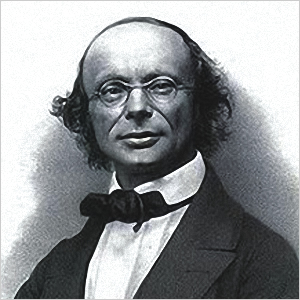Wilhelm Eduard Weber
Created and Claimed by pgupta66 (Priya Gupta). PHYS 2212.
Wilhelm Eduard Weber was a German physicist who discovered theories about magnetic flux, electrodynamics and magnetic maps.

Early Years and Career
Wilhelm Eduard Weber (1804-1891) was a German physicist born in Wittenberg who was the second of three brothers. Weber received his PhD from the University of Halle in natural philosophy and then was hired by the University of Gottingen to be a professor of physics at the age of 27. Weber always believed that physics could never be taught by simply speaking about it, applications to daily life were necessary. Therefore, he always encouraged his students to experiment themselves in the college laboratory. Weber collaborated with many scientists throughout his career. In 1859, he received the Copley Medal for his work with magnetic maps. He holds the honor of the SI unit of magnetic flux being named after him, which led to further electromagnetic discoveries.
Establishment
During his time at the University of Halle, he collaborated with his brother Ernst Weber and published works on organ pipes and coupled oscillators. Afterwards, they wrote a book on Wave Theory and Fluidity. This contained a detailed account of the experimental investigations on surface waves in liquids, and on sound and light waves.
Telegraph
Once hired by the University of Gottingen, Wilhelm Weber began his collaboration with Carl Friedrich Gauss. Together, they initiated a network of magnetic observatories and correlate the resulting measurements. In 1833, they developed the first electromagnetic telegraph, which functioned as a battery-operated telegraph line that was 9,000 meters long stretching from the physics laboratory to the astronomical observatory. Later, it was modified to use induced currents rather than battery power.
Magnetic Maps and Electrodynamics
Perhaps one of Weber’s more notable accomplishments, collaborated with Carl Freidrich Gauss and Carl Wolfgang Benjamin Goldschmidt, was the Atlas of Geomagnetism: According to the Elements and Theory of Design that eventually gave rise to the institutionalization of magnetic observatories.
In 1856, Weber had become the director of the astronomical observatory and began research with Rudolph Kohlrausch to determine the ratio between the electrodynamic and electrostatic units of charge. This led to Weber’s research on electric oscillations, which played a huge role in Weber’s development of his theory of electrodynamics. This theory helped James Clerk Maxwell’s theory that light is an electromagnetic wave. Even though this theory is not mentioned/taught anymore, it states that Coloumb’s law is velocity dependent.

This theory can be derived from potential energy and can be used to drive Ampere’s Law and Faraday’s law. In this law, all particles regardless of size and mass will follow Newton’s third law. While Maxwell’s equations incorporates conservation of particle momentum and particle angular momentum.
The collaboration between Weber and Kohlrausch led to the first use of the letter ‘c’ to denote the speed of light. In 1864, Weber published a book: Electrodynamic Proportional Measures containing a system of absolute measurements for electric currents, which eventually led to the SI unit for electric flux to be named after Weber (Wb).
Further sources
https://www.youtube.com/watch?v=cFKONUBBHQw
The World’s First Transatlantic Telegraph Cable
References
http://www.britannica.com/biography/Wilhelm-Eduard-Weber
http://www.thefamouspeople.com/profiles/wilhelm-weber-551.php